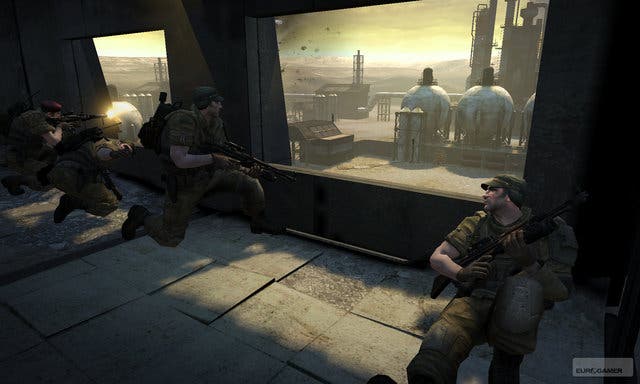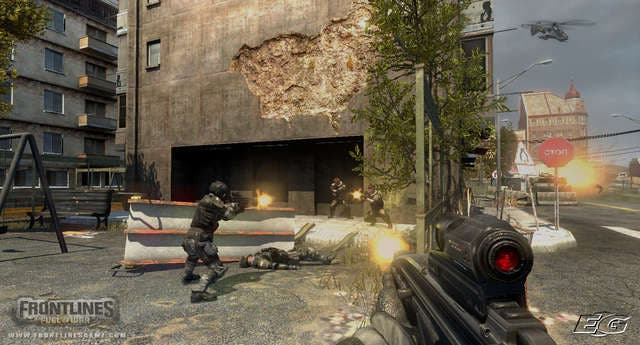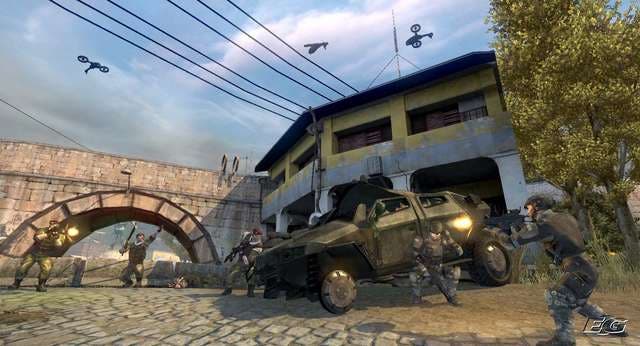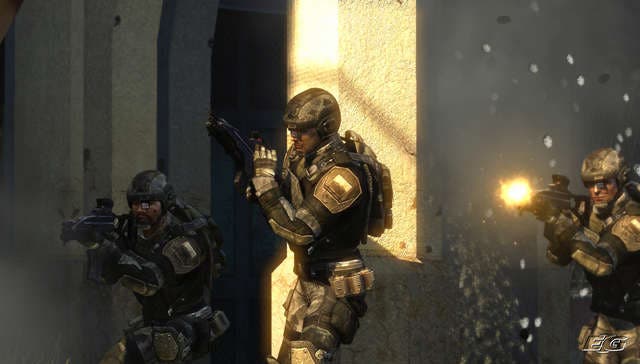Frontlines: Fuel of War
More oil and troubled waters.
The year is 2024, and there is little remaining of the planet Earth's precious oil reserves. Everyone lives in windmills made out of solar panels, children are put to work on specially modified bicycles to power their mums' hairdryers and there is a growing shortage of potatoes as everyone is forced to use those clocks they sell up the Science Museum.
All right, that's not quite the vision of the future presented in Frontlines: Fuel of War, the new PC, PS3 and Xbox 360 shooter from Kaos Studios. The year is 2024 and there is little remaining of the planet Earth's precious oil reserves, but the game features little if any reference to metal windmills and potato clocks, sadly.
In fact, it's all about the battle between the Western Coalition (the US and European Union) and the Red Star Alliance (China and Russia) who are battling for oil. As a member of the coalition, your mission is to use a variety of cutting edge weapons and vehicles to invade enemy territory, secure the reserves and kill plenty of foreigners.
Path finding

So, yes, it's another futuristic shooter. But as design director Dave Votypka explains, Kaos is determined to make the solo mode different from what you might be expecting. "A lot of the single player war games out there are very scripted, very linear. The designers want to craft the exact experience for the player," he says.
"We want to give you a big, open environment and lots of different ways to go about it - lots of different weapons to use, lots of different paths to take, lots of choices to make. It's all about letting the player choose how they want to play the game."
But it's not just about choosing your own adventure, according to Kaos boss Frank DeLise. The development team also wanted to capture some of the elements you only currently get in multiplayer shooters like Battlefield, and present them in the single player game.
"Back in 2001, we created Desert Combat because there weren't any modern military games then. Now, again, it's about what's missing for us as gamers," he says.
"We felt the intensity was missing; we felt a good multiplayer game on the console side was missing, and the single player side was lacking. Battlefield is good at letting you go anywhere and do anything with vehicles, and in a sense all new FPSes are going to have that. It's about what you can put on top of that which is new - so we think this is an evolution of the genre with a high level of intensity."
Pushing the boundaries

One of the features of Frontlines, is, well, frontlines, which are shown on a mini-map so you can keep an eye on how well you're doing at forcing the enemy to retreat. You'll see several objectives at various points along the frontline, and it's up to you to decide which ones to complete first.
"We wanted to create a non-linear experience, where the game isn't scripted," DeLise reaffirms. "It's completely open; you can go anywhere you want, capture objectives in any order you want, but there's still cinematic intensity."
Then there's the respawn system, which clearly takes its cues from multiplayer shooters. There aren't fixed checkpoints which you'll always return to - if you don't make it the fight will carry on around your dead body, and you'll have a choice of where to respawn depending on the objectives you've already completed. Whilst dead, you can also adjust the arsenal of weapons at your disposal.
And there's a wide range to choose from - Frontlines features more than 60 weapons and vehicles in total. They're all fictional, but based on current technology and research into what tomorrow's soldiers might be using (not AK-47s powered by King Edwards, disappointingly).
"We took weapons that are being designed or prototyped today, and projected them approximately 20 years into the future," says DeLise. "We call it Kaos Theory. The game is set in 2024, so we look at military.com, the History Channel and so on; we look at where stuff is going, then we take it forward.
"We also work from the idea that China and Russia are developing weapons together, sharing military R&D. Which is actually based on what's going on currently, because China's buying a lot of weapons from Russia, trying to fill their stockpile."
A key focus for weapon designers, DeLise explains, is "trying to get less soldiers on the battlefield, but more..." Death? "More... Survivability. So they've started using remote control drones which can drive into a house to see if it's safe. That's the first step they're taking now, but they want to develop ones that fly, stuff like that. So we're putting a lot of next-gen drone tech in there."
Attack of the drones

You will indeed find flying drones in Frontlines. Using remote control, you can send them swooping into the window of a building and they'll tell you how many people are hiding out and where they're positioned. There are also machine gun-enabled and mortar-enabled drones, and tiny land-based ones which you can drive under tanks before detonating. "The drones are pretty cool technology that definitely change the way a first-person shooter plays," observes DeLise.
In the single player game you can only fight for the Western Coalition, but you also get to try out Red Star Alliance weapons as you can pick up anything dead enemies drop. In addition, as you take over new areas of territory, you'll get your hands on stuff they've left lying around.
It's important to take advantage of this and get to know how the various weapons work if you're planning to fight for the RSA in multiplayer mode. A minimum of 32 players can battle it out, but that number could well increase - during the demo we saw, 112 people from as far apart as New York and California were bumping each other off.
"Consoles don't have a lot of large-scale multiplayer games, they don't have a lot of intensity. So we wanted to do 32-plus players on all platforms," says DeLise.
Just as in the single player game, multiplayer sees the two sides battling for control of the frontline, using both weapons and vehicles to achieve their objectives.
You can select your character class from the likes of heavy assault, sniper, anti-armour, close combat and so on, which determines the range of weapons you're equipped with. Then there are four different roles to choose from - you might like to specialise in controlling drones, ordering air strikes, managing countermeasures or providing ground support. Which ever one you go for, you'll be able to learn three new abilities as you fight in multiplayer battles.
Under control

However, the way you use weapons will depend on the version of the game you're playing. Frontlines PS3 will make use of the SIXAXIS controller's motion-sensing functionality - you'll be able to tip it forward to throw grenades, or tilt it sideways or backwards to pull off melee moves.
"We're trying everything we can and seeing what works and what doesn't," says DeLise. "It adds a different feel, gives you different abilities. Some people love it, some people just want to go straight, but I think it's going to definitely add value to the PS3 version."
Seeing as they're incorporating motion-sensing mechanics into the PS3 version, why not do a Wii game? "Right now, we're really pushing the envelope of the next-gen platforms. Some of our levels are over four miles wide," says DeLise. "Also we're using the Unreal 3 Engine, which is currently made for PC, PS3 and 360 - and not the Wii."
If you're playing Frontlines on PC, you'll be able to use the Xbox 360 controller - "You plug it in and it's automatically enabled." Kaos is currently considering making the game Live for Windows compatible, so PC owners may be able to rack up achievement points and play multiplayer games with 360 owners. Nothing's been confirmed yet, however.
But one thing's for sure - Frontlines: Fuel of War is looking nicely polished at this stage, which bodes well considering the game's due out in the autumn. True, it's not looking altogether dissimilar to Battlefield, but that's good news for console-only gamers who haven't had the pleasure.
Plus there are some very interesting touches, like the wide range of drones and the role system, not to mention multiplayer matches for at least 32 players. Here's hoping oil reserves will last long enough that you won't have to hook your games machine up to a bicycle to play it.


